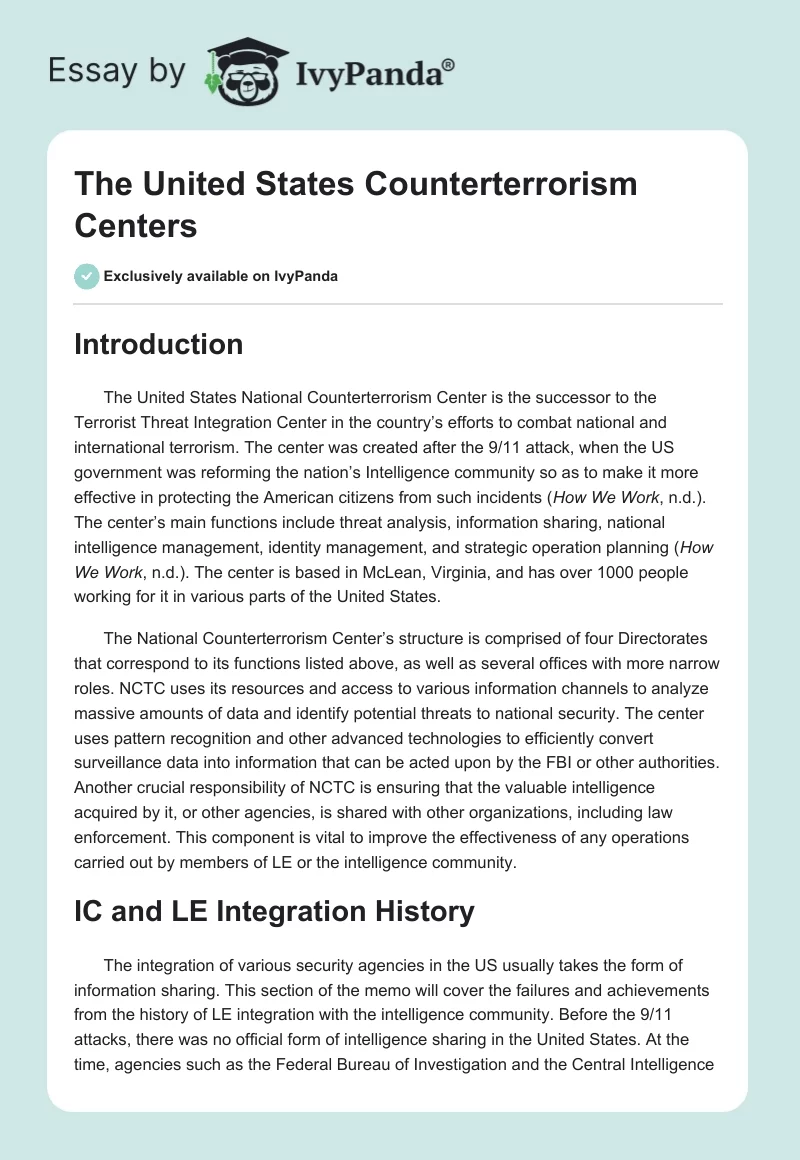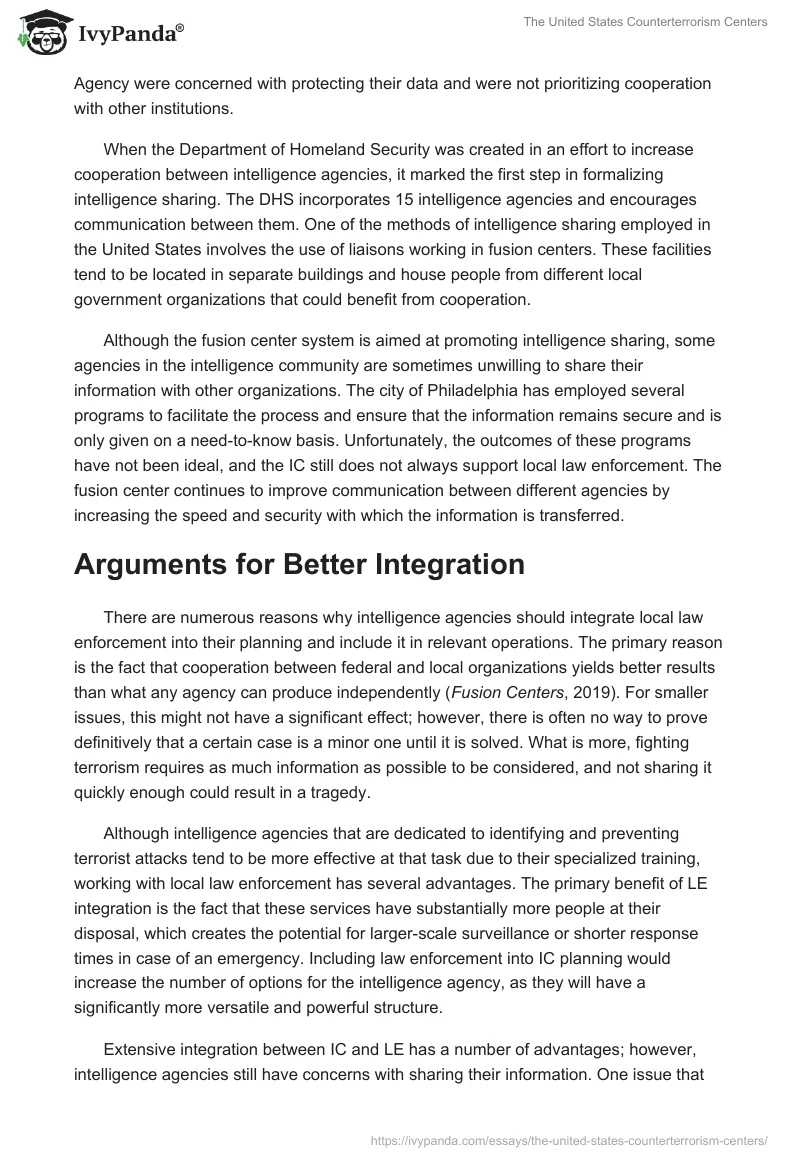Introduction
The United States National Counterterrorism Center is the successor to the Terrorist Threat Integration Center in the country’s efforts to combat national and international terrorism. The center was created after the 9/11 attack, when the US government was reforming the nation’s Intelligence community so as to make it more effective in protecting the American citizens from such incidents (How We Work, n.d.). The center’s main functions include threat analysis, information sharing, national intelligence management, identity management, and strategic operation planning (How We Work, n.d.). The center is based in McLean, Virginia, and has over 1000 people working for it in various parts of the United States.
The National Counterterrorism Center’s structure is comprised of four Directorates that correspond to its functions listed above, as well as several offices with more narrow roles. NCTC uses its resources and access to various information channels to analyze massive amounts of data and identify potential threats to national security. The center uses pattern recognition and other advanced technologies to efficiently convert surveillance data into information that can be acted upon by the FBI or other authorities. Another crucial responsibility of NCTC is ensuring that the valuable intelligence acquired by it, or other agencies, is shared with other organizations, including law enforcement. This component is vital to improve the effectiveness of any operations carried out by members of LE or the intelligence community.
IC and LE Integration History
The integration of various security agencies in the US usually takes the form of information sharing. This section of the memo will cover the failures and achievements from the history of LE integration with the intelligence community. Before the 9/11 attacks, there was no official form of intelligence sharing in the United States. At the time, agencies such as the Federal Bureau of Investigation and the Central Intelligence Agency were concerned with protecting their data and were not prioritizing cooperation with other institutions.
When the Department of Homeland Security was created in an effort to increase cooperation between intelligence agencies, it marked the first step in formalizing intelligence sharing. The DHS incorporates 15 intelligence agencies and encourages communication between them. One of the methods of intelligence sharing employed in the United States involves the use of liaisons working in fusion centers. These facilities tend to be located in separate buildings and house people from different local government organizations that could benefit from cooperation.
Although the fusion center system is aimed at promoting intelligence sharing, some agencies in the intelligence community are sometimes unwilling to share their information with other organizations. The city of Philadelphia has employed several programs to facilitate the process and ensure that the information remains secure and is only given on a need-to-know basis. Unfortunately, the outcomes of these programs have not been ideal, and the IC still does not always support local law enforcement. The fusion center continues to improve communication between different agencies by increasing the speed and security with which the information is transferred.
Arguments for Better Integration
There are numerous reasons why intelligence agencies should integrate local law enforcement into their planning and include it in relevant operations. The primary reason is the fact that cooperation between federal and local organizations yields better results than what any agency can produce independently (Fusion Centers, 2019). For smaller issues, this might not have a significant effect; however, there is often no way to prove definitively that a certain case is a minor one until it is solved. What is more, fighting terrorism requires as much information as possible to be considered, and not sharing it quickly enough could result in a tragedy.
Although intelligence agencies that are dedicated to identifying and preventing terrorist attacks tend to be more effective at that task due to their specialized training, working with local law enforcement has several advantages. The primary benefit of LE integration is the fact that these services have substantially more people at their disposal, which creates the potential for larger-scale surveillance or shorter response times in case of an emergency. Including law enforcement into IC planning would increase the number of options for the intelligence agency, as they will have a significantly more versatile and powerful structure.
Extensive integration between IC and LE has a number of advantages; however, intelligence agencies still have concerns with sharing their information. One issue that makes organizations hesitate to share their information is the fact that they expect the process to be mostly one-directional. However, equal sharing is one of the core values of fusion centers, and most agencies have unique intelligence that could benefit other organizations and are encouraged to share it. Another issue is the limitations on what information should or should not be shared, which seems to be an area of uncertainty for some agencies. Having general guidelines regarding the types of situations that warrant notifying other authorities partially resolves this issue, and other information can be given if it is requested.
Another issue is the speed of information sharing between different departments and agencies. With modern methods of communication, information can be transmitted almost instantly to any location, but that does not always coincide with the high standards of security that intelligence agencies adhere to. However, as potential terrorists and other dangerous elements do use instant messages for communication, the authorities need to have a similarly effective method. When carrying out special operations, some details can be discovered at the last moment, and it is crucial to communicate them to the operatives as quickly as possible. This is usually not an issue; however, if the intelligence is found by a different agency, some time may pass before it can reach the people who need it. To avoid this problem, the intelligence community needs to integrate law enforcement into its communication and share information without unnecessary delays.
To sum up, the intelligence community has several substantial reasons to support law enforcement with information and include it in their planning. The combined efforts of different agencies can result in more effective protection for the American nation. There are some issues with the efficiency and speed of communication at the current level of integration, and they could be resolved if the integration progressed further.
IC Capabilities and Limitations in Targeting Gangs
Philadelphia is not a particularly gang-ridden city, and large gangs, in general, are becoming less common in the developed world. The Philadelphia crime family, also known as the Philadelphia Mafia or the Philly Mafia is one of the few criminal organizations that remains operational from the beginning of the 20th century. The family is known for its violent tendencies, many mob wars, and numerous other crimes. The family is currently one of the most prominent gangs in the area, even after continuous efforts from law enforcement.
The city could use any help it can get with combating organized crime. Although law enforcement would theoretically be able to carry out a large-scale operation to capture some of the gang members and weaken the criminal family, it would not have a significant long-term effect. It is crucial to eliminate the entire structure, leaving no gang members free. Because this needs to be done in a short period of time, the police have to gather a substantial amount of information regarding the names and possible locations of people involved in a certain gang. Common investigation techniques and surveillance methods can lead to the arrests of some members of the gang; however, they are unlikely to know any information that could help bring the other criminals to justice.
Intelligence agencies could be able to provide some valuable assistance that might play a vital role in defeating the Philadelphia crime family. IC has impressive capabilities in terms of surveillance and data analysis. They could use advanced facial recognition software in combination with other less-known tools to track the activities of suspects, study their contacts, and gather data, without raising suspicion. They could also use their network of agents to infiltrate the criminal organization and learn about the practices they use to avoid getting caught. However, the capabilities of IC are not limitless, and organized crime leaders are notoriously resilient to most surveillance tactics. Although the intelligence community could provide some helpful information regarding this gang, there is no guarantee that this effort will result in the elimination of the Philadelphia crime family.
References
Fusion Centers. (2019). Homeland Security. Web.
How We Work. (n.d.). The National Counterterrorism Center.


